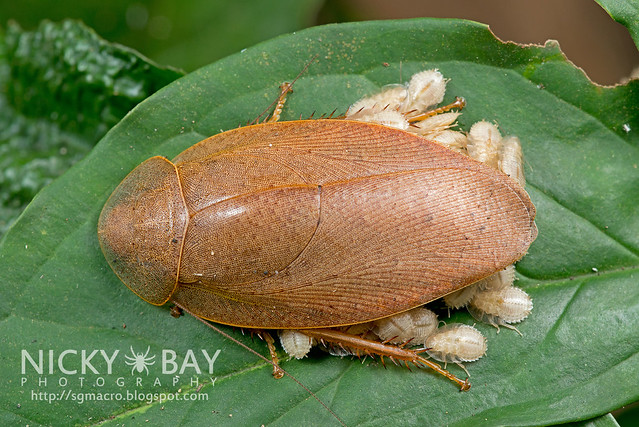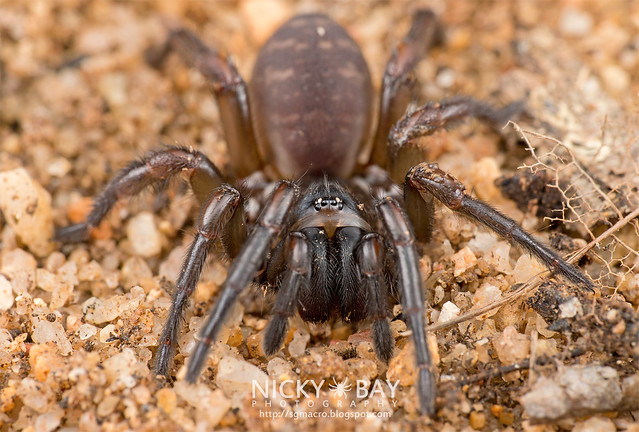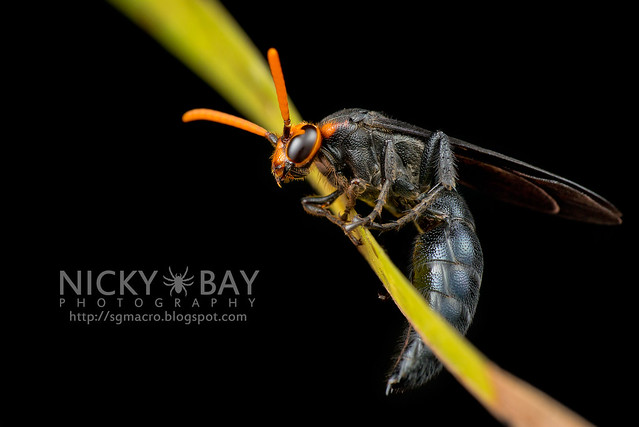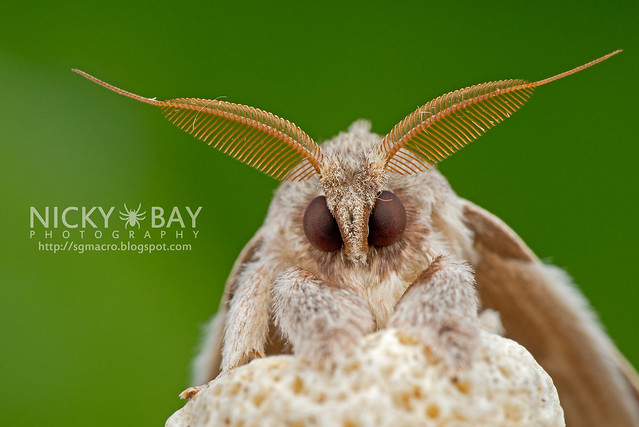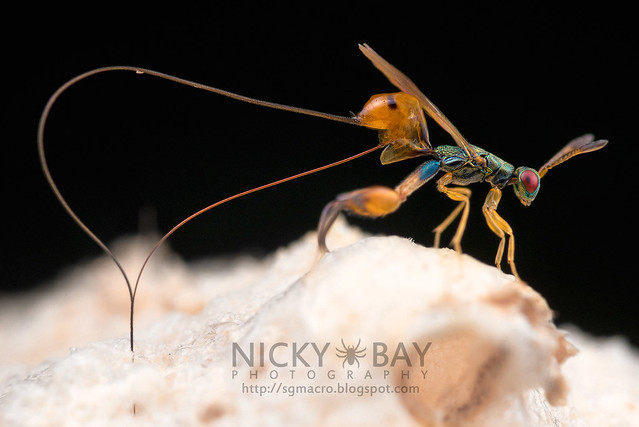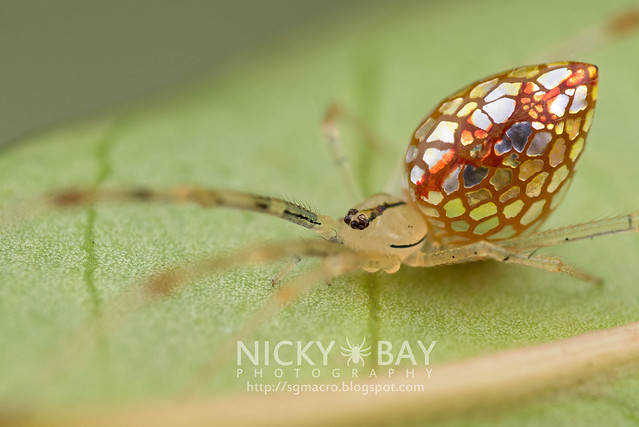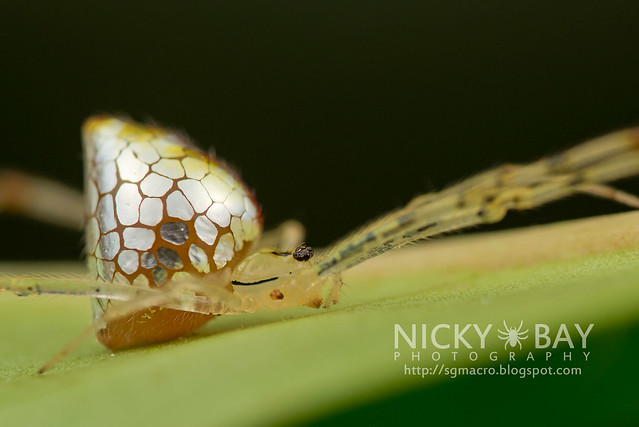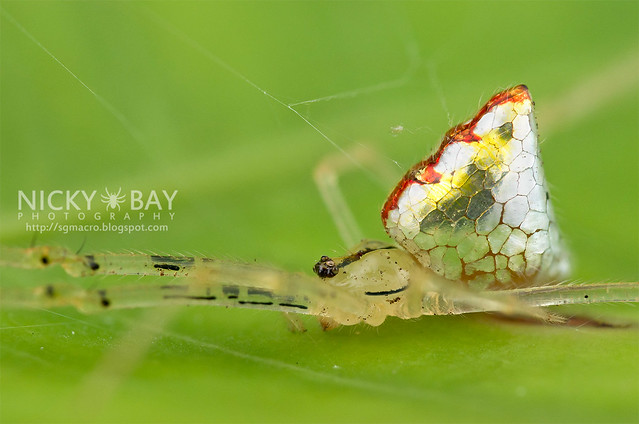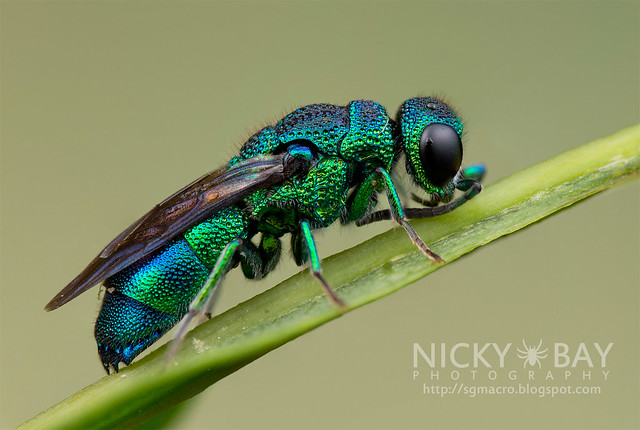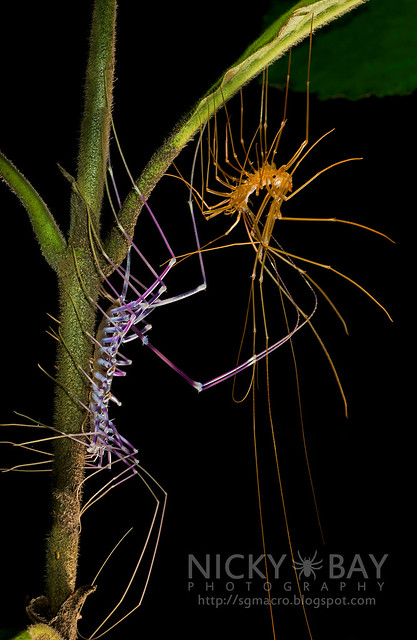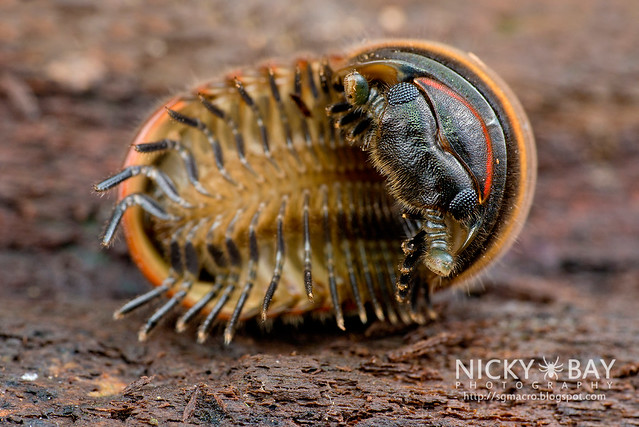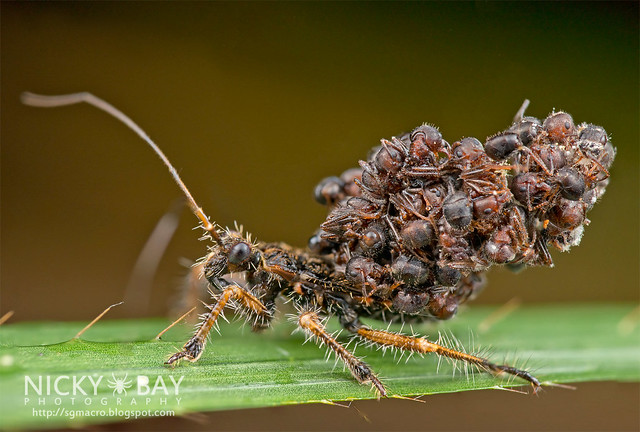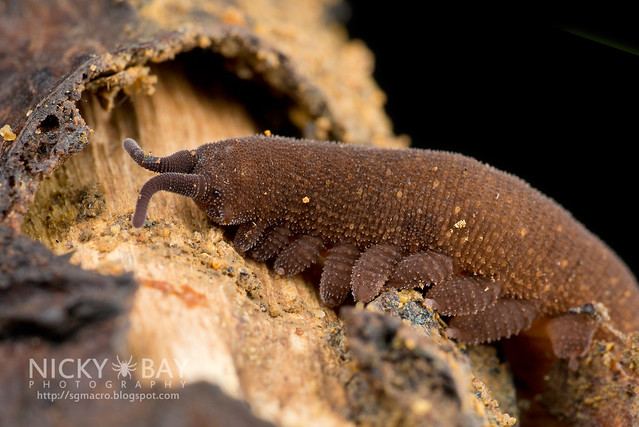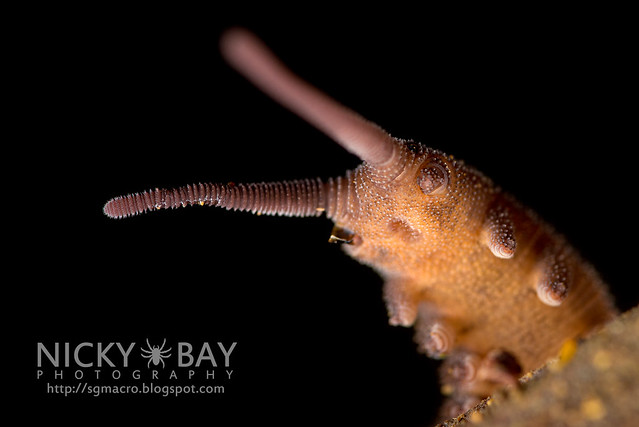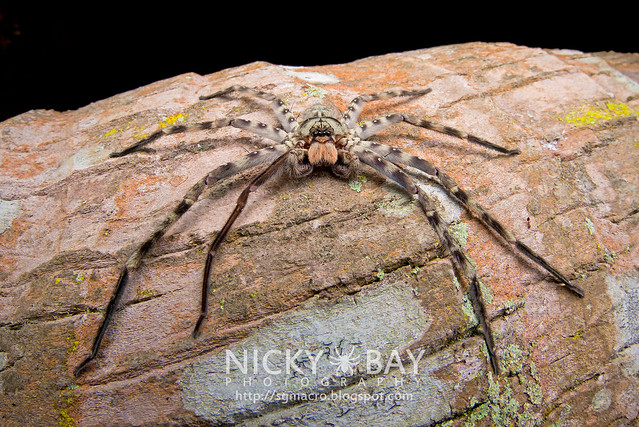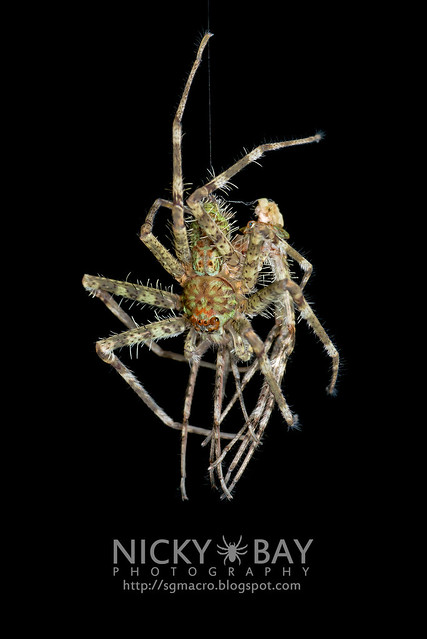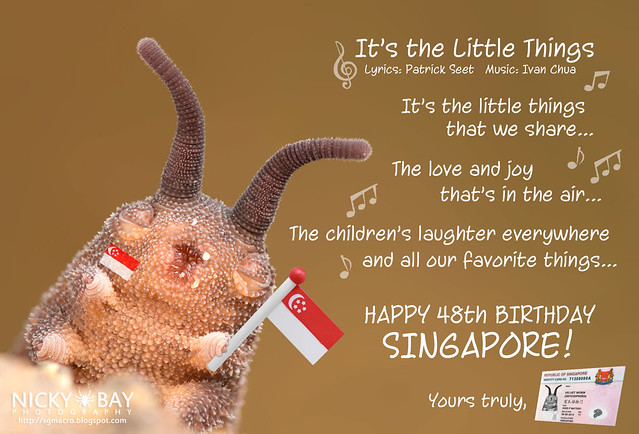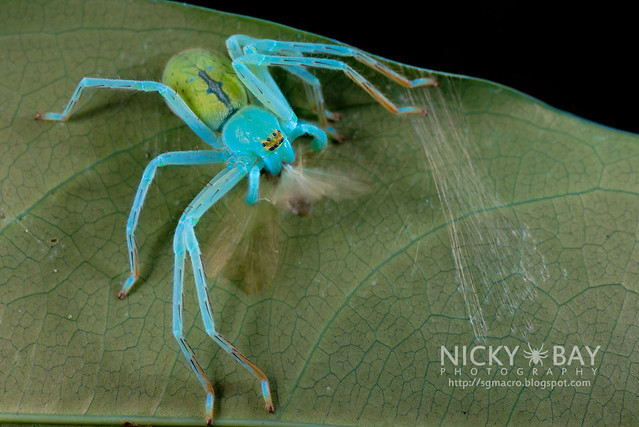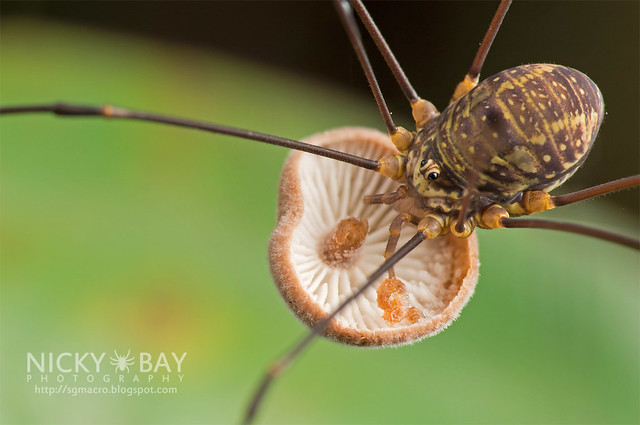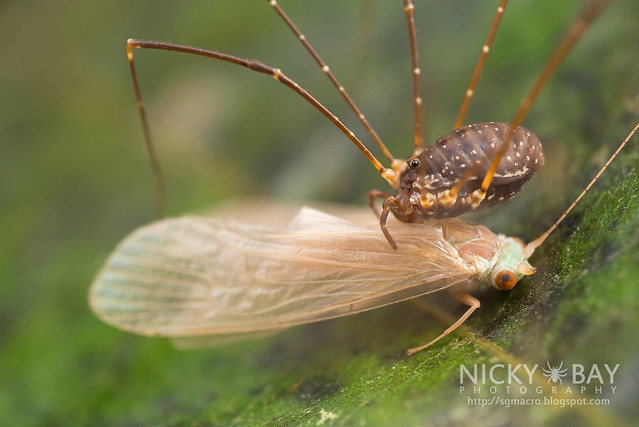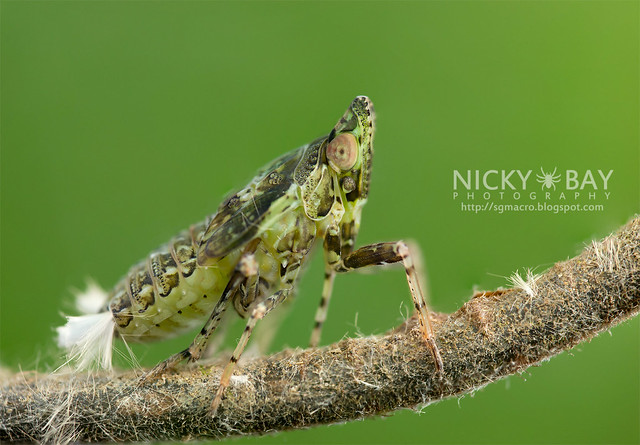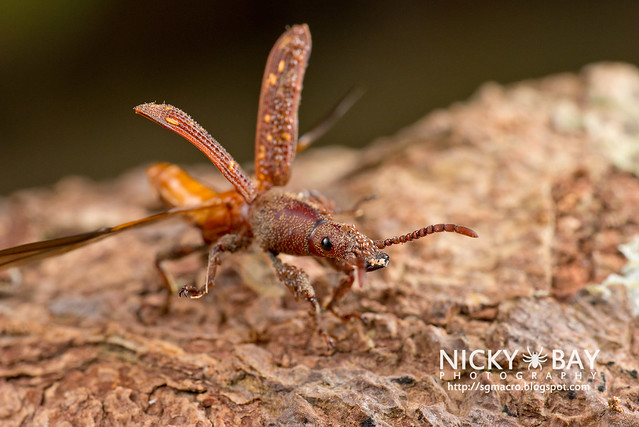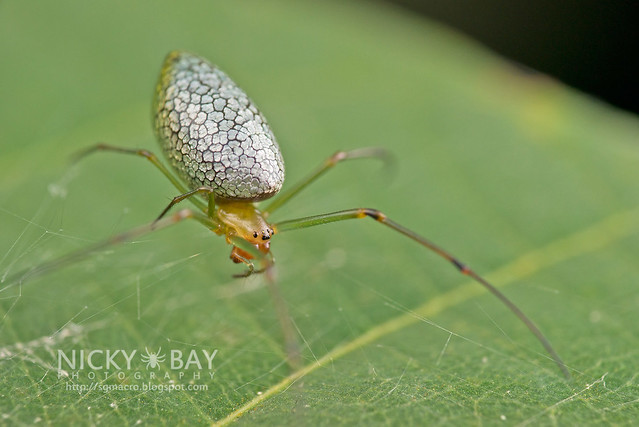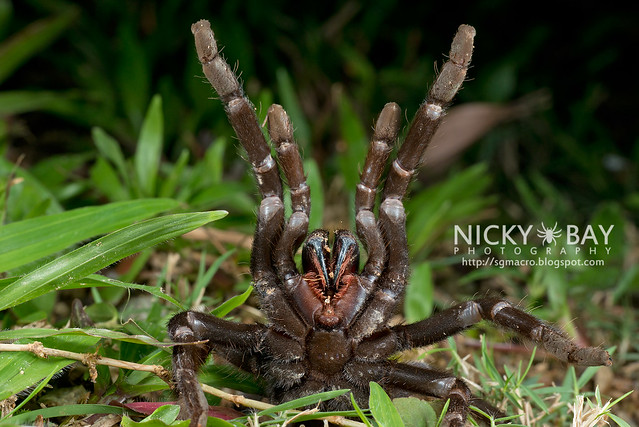Whip Scorpions belong to the order Thelyphonida, and I would consider them to be "cousins" of spiders and other scorpions. They are also called Vinegarroons, because of their defence mechanism -- spraying acetic acid from glands near the rear of the abdomen which smell very much like vinegar. As expected, I was the target of the "vinegar spray" on this night...
For this shoot, I got back to using the Tamron SP AF 90mm f/2.8 Di Macro lens, very light and great lens to use! Only drawback is that the lens extends a tad too much. I had sold this lens 2 years ago, and got it back for some hand-held adventures... the result? Many more subjects!!
Just a basic taxonomic structure for the Arachnids with the common orders:
![Whip Scorpion (Thelyphonida) - DSC_4141]() #1 Found the Whip Scorpion! But quite dirty as it was digging around the mud.
#1 Found the Whip Scorpion! But quite dirty as it was digging around the mud.
![Whip Scorpion (Thelyphonida) - DSC_4164]() #2 Chased it onto a tree's exposed root.
#2 Chased it onto a tree's exposed root.
![Whip Scorpion (Thelyphonida) - DSC_4177]() #3 Glorious dorsal view. It has 6 legs for walking, and 2 front legs modified as sensory organs. The pedipalps are pincer-like, resembling that of a scorpion.
#3 Glorious dorsal view. It has 6 legs for walking, and 2 front legs modified as sensory organs. The pedipalps are pincer-like, resembling that of a scorpion.
![Whip Scorpion (Thelyphonida) - DSC_4182]() #4 An ant came to disturb. Maybe it started spraying because of the irritating ant!!
#4 An ant came to disturb. Maybe it started spraying because of the irritating ant!!
![Whip Scorpion (Thelyphonida) - DSC_4184]() #5 A closer look at the pedipalps. Not exactly pincers as they cannot "pince" on it's own
#5 A closer look at the pedipalps. Not exactly pincers as they cannot "pince" on it's own
![Whip Scorpion (Thelyphonida) - DSC_4189]() #6 Quite scary looking, but no venom! :)
#6 Quite scary looking, but no venom! :)
![Whip Scorpion (Thelyphonida) - DSC_4194]() #7 This should be where the "vinegar" came from!!
#7 This should be where the "vinegar" came from!!
![Whip Scorpion (Thelyphonida) - DSC_4198]() #8 This whip-like tail is also a sensory organ. Despite the spikey look, it is not a weapon.
#8 This whip-like tail is also a sensory organ. Despite the spikey look, it is not a weapon.
![Whip Scorpion (Thelyphonida) - DSC_4201]() #9 Final look at the vinegar-emitting glands
#9 Final look at the vinegar-emitting glands
![Huntsman Spider (Sparassidae) - DSC_4051]() #10 Tiny little huntsman spider, might be mistaken to be a Sac Spider
#10 Tiny little huntsman spider, might be mistaken to be a Sac Spider
![Corinnidae, Utivarachna phyllicola - DSC_4041]() #11 Sac Spider (Utivarachna phyllicola). Seems very common at first glance, but the front row of eyes could tell a different story.
#11 Sac Spider (Utivarachna phyllicola). Seems very common at first glance, but the front row of eyes could tell a different story.
![Huntsman Spider (Sparassidae) - DSC_4053]() #12 Another view of the tiny huntsman spider
#12 Another view of the tiny huntsman spider
![Crab Spider (Thomisidae) - DSC_4058]() #13 Crab spider (Thomisidae) with a grumpy face
#13 Crab spider (Thomisidae) with a grumpy face
![Crab Spider (Thomisidae) - DSC_4062]() #14 Then again, most crab spiders do not look particularly happy!
#14 Then again, most crab spiders do not look particularly happy!
![Nursery Web Spider (Pisauridae) - DSC_4085]() #15 Nursery Web Spider (Pisauridae)
#15 Nursery Web Spider (Pisauridae)
![Bristletail (Thysanura) - DSC_4087]() #16 Jumping Bristletail? (Machilidae?)
#16 Jumping Bristletail? (Machilidae?)
![Stick Insect (Phasmatodea) - DSC_4151]() #17 Cute little stick insect was standing beside the Whip Scorpion, but everyone ignored it. I took a record shot and it turned out to be quite a beauty!
#17 Cute little stick insect was standing beside the Whip Scorpion, but everyone ignored it. I took a record shot and it turned out to be quite a beauty!
![Water Scorpion (Nepidae) - DSC_4129]() #18 Found something in the stream! This is the end of the breathing tube of a water scorpion (Nepidae) on the water surface
#18 Found something in the stream! This is the end of the breathing tube of a water scorpion (Nepidae) on the water surface
![Water Scorpion (Nepidae) - DSC_4123]() #19 Full view of the water scorpion. It is actually a true bug and not related to scorpions at all. Name was given because of this posture which resembles scorpions.
#19 Full view of the water scorpion. It is actually a true bug and not related to scorpions at all. Name was given because of this posture which resembles scorpions.
![Water Scorpion (Nepidae) - DSC_4206]() #20 Shooting through the water, face to face with the water scorpion!
#20 Shooting through the water, face to face with the water scorpion!
![Water Scorpion (Nepidae) - DSC_4227]() #21 Didn't look too happy and tried to hide behind the leaves
#21 Didn't look too happy and tried to hide behind the leaves
![Geosesarma nemesis - DSC_4233]() #22 Vampire Crab (Geosesarma nemesis) found running around on leaves and on the stream.
#22 Vampire Crab (Geosesarma nemesis) found running around on leaves and on the stream.
![Geosesarma nemesis - DSC_4238]() #23 Stood still enough for me to take a passport photo :)
#23 Stood still enough for me to take a passport photo :)
![Geosesarma nemesis - DSC_4262]() #24 Beautiful bright colouration!
#24 Beautiful bright colouration!
![Geosesarma nemesis - DSC_4266]() #25 And then there were two on the wooden railing...
#25 And then there were two on the wooden railing...
![Geosesarma nemesis - DSC_4275]() #26 Cute pair of vampire crabbies
#26 Cute pair of vampire crabbies
![Tadpole - DSC_4280]() #27 The stream had tadpoles too.. looks like a smiley face???
#27 The stream had tadpoles too.. looks like a smiley face???
![Tadpole - DSC_4327]() #28 From the underside, we could see through the body and examine the internal organs...
#28 From the underside, we could see through the body and examine the internal organs...
![Harvestman (Opiliones) - DSC_4290]() #29 Harvestman which we commonly call the gummybear
#29 Harvestman which we commonly call the gummybear
![Harvestman (Opiliones) - DSC_4299]() #30 Side view of the harvestman
#30 Side view of the harvestman
![Harvestman (Opiliones) - DSC_4303]() #31 Ran onto a bright yellow leaf
#31 Ran onto a bright yellow leaf
![Harvestman (Opiliones) - DSC_4308]() #32 Closed up when it felt a little threatened
#32 Closed up when it felt a little threatened
![Harvestman (Opiliones) - DSC_4312]() #33 Started running again!!
#33 Started running again!!
![Harvestman (Opiliones) - DSC_4317]() #34 Looks much nicer spread open
#34 Looks much nicer spread open
![Harvestman (Opiliones) - DSC_4320]() #35 Final shot of the gummy bear
#35 Final shot of the gummy bear
![Huntsman Spider (Sparassidae) - DSC_4332]() #36 Beautiful looking Huntsman Spider (Sparassidae)
#36 Beautiful looking Huntsman Spider (Sparassidae)
![Huntsman Spider (Sparassidae) - DSC_4336]() #37 Bright orange legs with dark (black?) carapace
#37 Bright orange legs with dark (black?) carapace
![Huntsman Spider (Sparassidae) - DSC_4337]() #38 Closer view of the face
#38 Closer view of the face
![Wandering Spider (Ctenidae) - DSC_4338]() #39 One of the many wandering spiders (Ctenidae) on the forest leaf litter
#39 One of the many wandering spiders (Ctenidae) on the forest leaf litter
![Wandering Spider (Ctenidae) - DSC_4340]() #40 Face shot of the wandering spider
#40 Face shot of the wandering spider
![Nursery Web Spider (Pisauridae) - DSC_4344]() #41 Nursery Web Spider (Pisauridae). One leg appears to be of a different colour. This is probably a regrown leg from a recent moult. Spiders can regrow lost legs from their moults, but that also means that they will not be able to regrow their legs if they had already undergone their last moult!
#41 Nursery Web Spider (Pisauridae). One leg appears to be of a different colour. This is probably a regrown leg from a recent moult. Spiders can regrow lost legs from their moults, but that also means that they will not be able to regrow their legs if they had already undergone their last moult!
![Huntsman Spider (Sparassidae) - DSC_4345]() #42 Final shot goes to the little Huntsman Spider that used to be classified as a Sac Spider
#42 Final shot goes to the little Huntsman Spider that used to be classified as a Sac Spider
The full album can be viewed here.
For this shoot, I got back to using the Tamron SP AF 90mm f/2.8 Di Macro lens, very light and great lens to use! Only drawback is that the lens extends a tad too much. I had sold this lens 2 years ago, and got it back for some hand-held adventures... the result? Many more subjects!!
Just a basic taxonomic structure for the Arachnids with the common orders:
- Class: Arachnida
- Order: Tailless Whip Scorpions (Amblypygi)
- Order: Spiders (Araneae)
- Order: Harvestmen (Opiliones)
- Order: Pseudoscorpions (Pseudoscorpionida)
- Order: Scorpions (Scorpiones)
- Order: Whip Scorpions (Thelyphonida)
- Order: Mites and Ticks (Acari)
 #1 Found the Whip Scorpion! But quite dirty as it was digging around the mud.
#1 Found the Whip Scorpion! But quite dirty as it was digging around the mud.  #2 Chased it onto a tree's exposed root.
#2 Chased it onto a tree's exposed root.  #3 Glorious dorsal view. It has 6 legs for walking, and 2 front legs modified as sensory organs. The pedipalps are pincer-like, resembling that of a scorpion.
#3 Glorious dorsal view. It has 6 legs for walking, and 2 front legs modified as sensory organs. The pedipalps are pincer-like, resembling that of a scorpion.  #4 An ant came to disturb. Maybe it started spraying because of the irritating ant!!
#4 An ant came to disturb. Maybe it started spraying because of the irritating ant!!  #5 A closer look at the pedipalps. Not exactly pincers as they cannot "pince" on it's own
#5 A closer look at the pedipalps. Not exactly pincers as they cannot "pince" on it's own  #6 Quite scary looking, but no venom! :)
#6 Quite scary looking, but no venom! :)  #7 This should be where the "vinegar" came from!!
#7 This should be where the "vinegar" came from!!  #8 This whip-like tail is also a sensory organ. Despite the spikey look, it is not a weapon.
#8 This whip-like tail is also a sensory organ. Despite the spikey look, it is not a weapon.  #9 Final look at the vinegar-emitting glands
#9 Final look at the vinegar-emitting glands  #10 Tiny little huntsman spider, might be mistaken to be a Sac Spider
#10 Tiny little huntsman spider, might be mistaken to be a Sac Spider  #11 Sac Spider (Utivarachna phyllicola). Seems very common at first glance, but the front row of eyes could tell a different story.
#11 Sac Spider (Utivarachna phyllicola). Seems very common at first glance, but the front row of eyes could tell a different story.  #12 Another view of the tiny huntsman spider
#12 Another view of the tiny huntsman spider  #13 Crab spider (Thomisidae) with a grumpy face
#13 Crab spider (Thomisidae) with a grumpy face  #14 Then again, most crab spiders do not look particularly happy!
#14 Then again, most crab spiders do not look particularly happy!  #15 Nursery Web Spider (Pisauridae)
#15 Nursery Web Spider (Pisauridae)  #16 Jumping Bristletail? (Machilidae?)
#16 Jumping Bristletail? (Machilidae?)  #17 Cute little stick insect was standing beside the Whip Scorpion, but everyone ignored it. I took a record shot and it turned out to be quite a beauty!
#17 Cute little stick insect was standing beside the Whip Scorpion, but everyone ignored it. I took a record shot and it turned out to be quite a beauty!  #18 Found something in the stream! This is the end of the breathing tube of a water scorpion (Nepidae) on the water surface
#18 Found something in the stream! This is the end of the breathing tube of a water scorpion (Nepidae) on the water surface  #19 Full view of the water scorpion. It is actually a true bug and not related to scorpions at all. Name was given because of this posture which resembles scorpions.
#19 Full view of the water scorpion. It is actually a true bug and not related to scorpions at all. Name was given because of this posture which resembles scorpions.  #20 Shooting through the water, face to face with the water scorpion!
#20 Shooting through the water, face to face with the water scorpion!  #21 Didn't look too happy and tried to hide behind the leaves
#21 Didn't look too happy and tried to hide behind the leaves  #22 Vampire Crab (Geosesarma nemesis) found running around on leaves and on the stream.
#22 Vampire Crab (Geosesarma nemesis) found running around on leaves and on the stream.  #23 Stood still enough for me to take a passport photo :)
#23 Stood still enough for me to take a passport photo :)  #24 Beautiful bright colouration!
#24 Beautiful bright colouration!  #25 And then there were two on the wooden railing...
#25 And then there were two on the wooden railing...  #26 Cute pair of vampire crabbies
#26 Cute pair of vampire crabbies  #27 The stream had tadpoles too.. looks like a smiley face???
#27 The stream had tadpoles too.. looks like a smiley face???  #28 From the underside, we could see through the body and examine the internal organs...
#28 From the underside, we could see through the body and examine the internal organs...  #29 Harvestman which we commonly call the gummybear
#29 Harvestman which we commonly call the gummybear  #30 Side view of the harvestman
#30 Side view of the harvestman  #31 Ran onto a bright yellow leaf
#31 Ran onto a bright yellow leaf  #32 Closed up when it felt a little threatened
#32 Closed up when it felt a little threatened  #33 Started running again!!
#33 Started running again!!  #34 Looks much nicer spread open
#34 Looks much nicer spread open  #35 Final shot of the gummy bear
#35 Final shot of the gummy bear  #36 Beautiful looking Huntsman Spider (Sparassidae)
#36 Beautiful looking Huntsman Spider (Sparassidae)  #37 Bright orange legs with dark (black?) carapace
#37 Bright orange legs with dark (black?) carapace  #38 Closer view of the face
#38 Closer view of the face  #39 One of the many wandering spiders (Ctenidae) on the forest leaf litter
#39 One of the many wandering spiders (Ctenidae) on the forest leaf litter  #40 Face shot of the wandering spider
#40 Face shot of the wandering spider  #41 Nursery Web Spider (Pisauridae). One leg appears to be of a different colour. This is probably a regrown leg from a recent moult. Spiders can regrow lost legs from their moults, but that also means that they will not be able to regrow their legs if they had already undergone their last moult!
#41 Nursery Web Spider (Pisauridae). One leg appears to be of a different colour. This is probably a regrown leg from a recent moult. Spiders can regrow lost legs from their moults, but that also means that they will not be able to regrow their legs if they had already undergone their last moult!  #42 Final shot goes to the little Huntsman Spider that used to be classified as a Sac Spider
#42 Final shot goes to the little Huntsman Spider that used to be classified as a Sac Spider The full album can be viewed here.




















































































































































